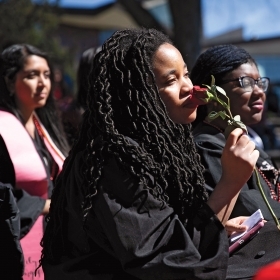When I returned to work in Green Hall in early September, in some ways, it seemed like time had been frozen at the moment we left campus. My calendar from 2020 was still on the...

When I returned to work in Green Hall in early September, in some ways, it seemed like time had been frozen at the moment we left campus. My calendar from 2020 was still on the wall. Our original story lineup for the summer 2020 issue was on our dry-erase board, in the handwriting of my former boss, Alice Hummer. I ill-advisedly opened a mini-fridge and found something else from March 2020 … or, judging by the smell, earlier.
One thing, though, made it stunningly clear just how much time had passed. When I walked from Beebe Hall, where I got my first weekly COVID-19 test, up the hill to the Academic Quad by Pendleton West, I was so surprised by the lush vegetation that enveloped me that I took a few minutes to pause and look around.
Five years ago, that steep hillside was utterly unremarkable, covered with grass and tidy rows of trees. But when Pendleton West was renovated in 2017, the hillside was replanted with native vegetation, designed to look like the rest of Norumbega Hill. Two seasons of growth, and a very rainy July, had transformed this corner of Wellesley. I was momentarily and pleasantly lost in the woods, a small forest that had grown up while my time on campus had been put on pause by the pandemic.
Being back on campus after a long hiatus has made it staggeringly clear how much the landscape is a part of the Wellesley experience. “The Wellesley campus has provided, and continues to provide, an expansive and inspiring natural context for teaching, learning, investigation, reflection, wonder,” Wendy Judge Paulson ’69, a conservation activist and the founder of the Paulson Ecology of Place Initiative, told Catherine O’Neill Grace for her feature story in this issue, “A Sense of Place,” page 20. Paulson added, “The opportunity to contemplate one of Keats’ poems in a spoonholder on the shores of Lake Waban, or to consider the sequence of a lab experiment on the way to the Science Center while you walk a path that meanders by Paramecium Pond, is an ongoing gift to generations of Wellesley students and alums.”
We’ve spent a lot of time thinking about Wellesley’s newest alums, the classes of ’20 and ’21, who were deprived of precious time on campus due to necessary COVID-19 precautions. How hard that must have been, and how challenging to take their first post-collegiate steps during a pandemic. Jennifer Garrett ’98 spoke with five alums from these classes and shares their stories in “The Pandemic Launch,” page 30. “I didn’t see a path for me to get from graduation to full employment. I already felt like I was going off the beaten path, and suddenly someone came and erased the path and destroyed the road that I was standing on,” Kalyani Saxena ’20 told Garrett. I am sure many alumnae—from all decades—can relate to this feeling. Perhaps even some of our 2021 Alumnae Achievement Award recipients, whose accomplishments you can read about on page 36.
Finally, we are so grateful to writer Amy Yee ’96 and the alumnae and faculty she interviewed for our cover story, “The Fight Against Invisibility,” about the hate that Asian Americans have long endured without national attention. On March 15, the day before the horrific shootings in Atlanta, Georgia State Sen. Michelle Au ’99 told her fellow senators, “All I’m asking right now, as the first East Asian state senator in Georgia, is simply to fully consider us as part of our communities. Recognize that we need help, we need protection, and we need people in power to stand up for us against hate.” One thing that gives me hope in spite of devastating news is the sheer number of people in the Wellesley community who are, like Au, standing up.
Thank you for reading the magazine.


